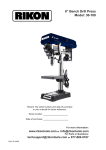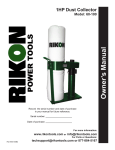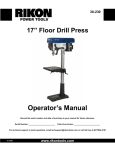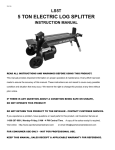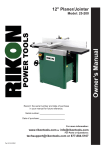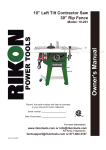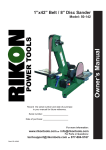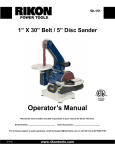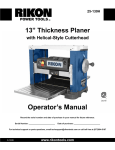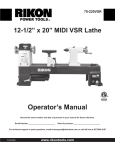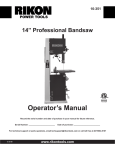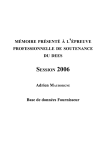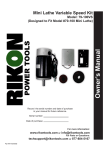Download Owner`s Manual - Highland Woodworking
Transcript
4” X 36”Belt & 6”Disc Sander Owner’s Manual Model: 50-112 Record the serial number and date of purchase in your manual for future reference. Serial number: Date of purchase: For more information: www.rikontools.com or [email protected] For Parts or Questions: Part # 50-112M1 [email protected] or 877-884-5167 Operator Safety: Required Reading IMPORTANT! Safety is the single most important consideration in the operation of this equipment. The following instructions must be followed at all times. There are certain applications for which this tool was designed. We strongly recommend that this tool not be modified and/or used for any other application other than that for which it was designed. If you have any questions about its application, do not use the tool until you have contacted us and we have advised you. General Safety Warnings KNOW YOUR POWER TOOL. Read the owner’s manual carefully. Learn the tool’s applications, work capabilities, and its specific potential hazards. ALWAYS GROUND ALL TOOLS. If your tool is equipped with a three-pronged plug, you must plug it into a three-hole electric receptacle. If you use an adapter to accommodate a two-pronged receptacle, you must attach the adapter plug to a known ground. Never remove the third prong of the plug. ALWAYS AVOID DANGEROUS ENVIRONMENTS. Never use power tools in damp or wet locations. Keep your work area well lighted and clear of clutter. ALWAYS REMOVE THE ADJUSTING KEYS AND WRENCHES FROM TOOLS AFTER USE. Form the habit of checking to see that keys and adjusting wrenches are removed from the tool before turning it on. ALWAYS KEEP YOUR WORK AREA CLEAN. Cluttered areas and benches invite accidents. ALWAYS KEEP VISITORS AWAY FROM RUNNING MACHINES. All visitors should be kept a safe distance from the work area. ALWAYS MAKE THE WORKSHOP CHILDPROOF. Childproof with padlocks, master switches, or by removing starter keys. NEVER OPERATE A TOOL WHILE UNDER THE INFLUENCE OF DRUGS, MEDICATION, OR ALCOHOL. ALWAYS WEAR PROPER APPAREL. Never wear loose clothing or jewelry that might get caught in moving parts. Rubber-soled footwear is recommended for the best footing. ALWAYS USE SAFETY GLASSES AND WEAR HEARING PROTECTION. Also use a face or dust mask if the cutting operation is dusty. NEVER OVERREACH. Keep your proper footing and balance at all times. NEVER STAND ON TOOLS. Serious injury could occur if the tool is tipped or if the cutting tool is accidentally 2 ALWAYS DISCONNECT TOOLS. Disconnect tools before servicing and when changing accessories such as blades, bits, and cutters. ALWAYS AVOID ACCIDENTAL STARTING. Make sure switch is in “OFF” position before plugging in cord. NEVER LEAVE TOOLS RUNNING UNATTENDED. ALWAYS CHECK FOR DAMAGED PARTS. Before initial or continual use of the tool, a guard or other part that is damaged should be checked to assure that it will operate properly and perform its intended function. Check for alignment of moving parts, binding of moving parts, breakage of parts, mounting, and any other conditions that may affect its operation. A guard or other damaged parts should immediately be properly repaired or replaced. Special Safety Rules For Belt & Disc Sanders 1.Do not operate this machine until you have read all of the following instructions. 2.Do not attempt to operate this machine until it is completely assembled. 3. Do not turn ON this machine if any pieces are missing. 4. If you are not familiar with the operation of the machine, obtain assistance from a qualified person. 5.It is highly recommended that this machine be firmly mounted to a flat and secure work surface or stand. 6.Always wear protective eyewear prior to operating this machine. 7.Do not operate this machine if you are under the influence of drugs and/or alcohol. 8.Remove all jewelry prior to operating this machine. 9.Do not wear any gloves while operating this machine. 10.Always make sure the power switch is in the OFF position prior to plugging in the machine. 11.Always make sure the power switch is in the OFF position when doing any assembly or setup operation. 12.Always wear a dust mask and use adequate dust collection and proper ventilation. Use of sanders can produce harmful particles while sanding certain types of woods. 13.The use of any accessories or attachments not recommended may cause injury to you and damage your machine. 14.This machine must be properly grounded. 15.Abrasive discs and belts should be the recommended width and length of the manufacturer. 16.Always keep your face and hands clear of moving parts such as belts and pulleys. 17.Keep power supply cords free of moving parts of the sander. Damaged cords can result in electric shock. 18.Maintain a 1/16” clearance between the sanding disc, sanding belt and tables 19.Always support the workpiece with the table or backstop. 20.Remove material or debris from the work area. Keep work area neat and clean. 21.Keep these instructions for future reference. California Proposition 65 Warning WARNING: Some dust created by power sanding, sawing, grinding, drilling, and other construction activities contains chemicals known to the State of California to cause cancer and birth defects or other reproductive harm.Your risk from exposure to these chemicals varies, depending on how often you do this type of work. To reduce your exposure, work in a well-ventilated area and with approved safety equipment, such as dust masks that are specially designed to filter out microscopic particles. For more detailed information about California Propostion 65 log onto rikontools.com. SAVE THESE INSTRUCTIONS. Refer to them often. 3 Table of Contents Safety Warnings..................................................................................................................................2-3 Sander Safety Rules ..........................................................................................................................3 Specifications ........................................................................................................................................4 Unpacking ............................................................................................................................4 Assembly ...........................................................................................................................5 Mounting Sanding Disc and Guard.........................................................................................................5 Assembling the Work Support Fence..........................................................................................6 Table Support Assembly....................................................................................................................6 Mounting the Table Assembly..................................................................................................7 Leveling the Table Assembly............................................................................................................8 Intalling the Sanding Belt ..........................................................................................................................7 Operation ...........................................................................................................................................7 On/Off Switch ............................................................................................................................................8 Electrical Requirements.......................................................................................................................9 Maintenance ...................................................................................................................................10 Timing Belt Replacement............................................................................................................................10 Trouble Shooting................................................................................................................................11 Wiring Diagram.................................................................................................................................11 Parts List .....................................................................................................................................12 Warranty .............................................................................................................................................15 Specifications Belt Size Belt Speed Disc Size Disc Speed Table Size Belt Table Tilt Disc Table Tilt Motor Amps Volts Net weight 4”x36” 1930 SFPM 6” 3420 SFPM 9” x 6-1/4” 0-90 o 45 o 1/2 HP 4.3 110 37 lbs Unpacking When unpacking, check to make sure the following parts are included. If any parts are missing or broken, please call RIKON Power Tools at the number on the cover of this manual as soon as possible. Item # Description Qty ---- 35 7 33 6 60 --- ---- Sander Body 1 Table 1 6” Sandpaper Disc 1 Table Support 1 Guard, Disc 1 Work Support 1 Miter Gauge 1 Plastic bag contains 1 assembly hardware. 4 Assembly Securing Sander Base Assembly to Workbench Belt and disc sander must be fastened securely to a firm supporting surface such as a workbench. OUTLINE OF SANDER 2 HOLES 10mm(3/8” Diameter) 68mm 2-21/32” 19mm (3/4”) 1. 2. 3. 4. 14mm (9/16”) 341mm (13-7/16”) Place sander in operational position on workbench. Place a pencil through the holes in the sander base (42) and mark drill holes in workbench. Remove sander and drill two 10mm (3/8”) dia. holes through the workbench. Align sander base over holes and secure using two 5/16” screws and hex. nuts Mounting Sanding Disc and Guard 1. 2. 3. 4. Locate sanding disc (7) and peel backing off disc. Align perimeter of sanding disc over plate. When aligned, press sandpaper disc firmly onto backing disc. Position disc guard (6) onto lower portion of sanding disc so that the mounting holes align. Using a Phillips screwdriver, fasten two pan head screws (found in parts bag) over disc guard. Disc (10) Pad, 6 inch Sandpaper (7) Disc Guard 5 Assembly Installing Work support 1. 2. Place work support (60) over sanding belt as shown in following illustration. Place the hex. screw (91) through the flat washer (90)and secure. Do not over tighten. Wrench Work Support (60) Table Support Assembly 1. 2. 3. Locate the table support (33) and hex. screws (31) and washers (32). Stand table (35) on its side, aligning holes as shown in below illustration. Fasten table support to table. Do not over tighten screws. Table Support (33) Table (35) 6 Assembly 4. Position table support (33) in corresponding holes on side of base as shown in below illustration. Index Pin Table Support (33) Base Washer (32) Knob (34) 5. Place washer (32) on knob (34) shaft and insert through slot into threaded holes in base. 6. Loosen the three hex. screws (31) and adjust table so that there is a maximum of 1.5mm (1/16”) space between the sanding disc and the table. Tighten screws. 1/16 in. Max between Sanding surface and Table Edge Table Angle Scale Operation The rocker ON/OFF power switch is located on the front of the sander, and incorporates a removable safety switch. 1. Press the side marked ON to turn the sander on. 2. Press the side marked OFF to turn the sander off. In situations where the sander may be left unattended, the operator has the option of removing the center safety portion of the ON/OFF switch to render the sander inoperable. When the operator is ready to use the machine again, the center safety portion of the switch may be reinstalled simply by inserting it into the opening in the switch and pushing it in until it “seats”. 7 Operation Remounting Table for Vertical Sanding 1. 2. 3. 4. 5. 6. Remove backstop lock bolt and remove work support. Unscrew knob (34) and remove. Pull table support (33) index pin out of mounting hole. Loosen hex socket screw (75) and raise sanding bed to the desired sanding position. Insert the table index pins into the auxiliary (upper) holes in the sanding bed. Tighten hex socket screw (75). Make sure table is not touching sanding belt. Table Support Auxiliary Mounting Holes Knob (1) Leveling Table Assembly 1. 2. 3. 4. Place a combination square on the table (35) so that it also touches the sanding pad (7). See below. If the table is 90 degrees to the pad, the square is flush on the pad. If the table is not 90 degrees to the with the pad, loosen the table lock knob (34) and tilt the table until the square is flush with the pad Retighten the knob to secure the table. Attach the scale label to the ‘0’ degrees mark on the dust guard. Table (35) Scale Label Table Lock Knob (34) 8 Operation Installing and Adjusting the Sanding Belt 1. 2. 3. 4. 5. 6. Turn power switch to the OFF position and disconnect power cord from the main elec tricity supply. Move tension lever (66) to the right to release the sanding belt tension (10). . Place the sanding belt over the drive and idler drums (13 and 65), making sure that the inside direction arrow points down, towards the drive drum (13) as shown in illustration.. Centre belt on both drums. Slide tension lever (66) to the left to tighten belt tension. Tighten hex. socket screw (56) when bed (4) is in desired working position. 7. 8. 9. Reconnect the power cord to the main electricity supply. Turn the no-volt release switch (21) ON, then OFF, while viewing the belt movement. If the belt looks like it was going to slide off either drum, the belt tracking needs to be adjusted (described in the next step). If the sanding belt (87) moves towards the sanding pad (7) when turned ON, turn the tracking knob (55) clockwise ¼ turn, and test again. If the sanding belt moves away from the sanding pad when it was turned ON, turn he tracking knob counterclockwise ¼ turn, and test again. Surface Sanding on Sanding Belt End Sanding on Sanding Belt Sanding Curved Edges 9 Electrical Requirements In the event of a malfunction or breakdown, grounding provides a path of least resistance for electric current to reduce the risk of electric shock. This tool is equipped with an electric cord having an equipment-grounding conductor and a grounding plug. The plug must be plugged into a matching outlet that is properly installed and grounded in accordance with all local codes and ordinances. Do not modify the plug provided. If it will not fit the outlet, have the proper outlet installed by a qualified electrician. Improper connection of the equipment-grounding conductor can result in a risk of electric shock. The conductor, with insulation having an outer surface that is green with or without yellow stripes, is the equipment-grounding conductor. If repair or replacement of the electric cord or plug is necessary, do not connect the equipment-grounding conductor to a live terminal. Check with a qualified electrician or service personnel if the grounding instructions are not completely understood, or if in doubt as to whether the tool is properly grounded. Use only three wire extension cords that have three-prong grounding plugs and three-pole receptacles that accept the tool’s plug.* Repair or replace a damaged or worn cord immediately. This tool is intended for use on a circuit that has an outlet that looks the one illustrated in Figure A below. The tool has a grounding plug that looks like the grounding plug as illustrated in Figure A below. A temporary adapter, which locks like the adapter as illustrated in Figure B below, may be used to connect this plug to a two-pole receptacle, as shown in Figure B if a properly grounded outlet is not available.** The temporary adapter should only be used until a properly grounded outlet can be installed by a qualified electrician. The green colored rigid ear or tab, extending from the adapter, must be connected to a permanent ground such as a properly grounded outlet box. * Canadian electrical codes require extension cords to be certified SJT type or better. ** Use of an adapter in Canada is not acceptable. 10 Wiring Diagram WARNING:This machine must be grounded. Replacement of the power supply cable should only be done by a qualified electrician. Maintenance Use this section to record maintenance, service and any calls to Technical Support: 11 Maintenance 1. 2. Apply a light coat of wax paste to the worktable to make feeding stock easier. Use a vacuum cleaner and brush to clear out dust and debris from sander and motor. Timing Drive Belt Replacement 1. 2. Using a Phillips screwdriver, remove the screw (66) from belt cover (67), and remove cover. Loosen three screws to allow drive pulleys (71 and 78) to move enough to place drive belt (70) around them . 12 Maintenance 3. 4. 5. 6. 7. 8. Place drive belt around drive pulley (71), then drive pulley (78). Tighten the three screws slightly. Adjust tension of drive belt by placing a standard screwdriver in the adjusting hole by pushing up on the screwdriver to apply tension to the drive belt. Tighten the three screws again. Squeeze the drive belt between two fingers in the centre of the belt. If the belt has been correctly tensioned there should be about 6mm (1/4”) of “give”. NOTE: Too much tension on the drive belt can load-down motor and possibly cause dam age. If the drive belt is too loose, it may fail prematurely. Replace belt cover (67) . Troubleshooting SYMPTOM PROBABLE CAUSE Not plugged in to power outlet. Power switch defective. Motor or wiring problem. Sander does not operate REMEDY Plug into power outlet. Replace switch. Have qualified electrician carry out repair. Timing belt too tight Decrease tension. Motor slows when sanding Applying too much pres Apply less pressure to workpiece when sure on workpiece. sanding. Wood burns while sanding Sanding disc or belt is Clean or replace disc or belt. loaded with debris. Sander makes excessive noise Timing belt too tight. Bearings need oil. 13 Decrease tension Oil bearings. Parts List Part No. 50-112-1 50-112-2 50-112-3 50-112-4 50-112-5 50-112-6 50-112-7 50-112-8 50-112-9 50-112-10 50-112-11 50-112-12 50-112-13 50-112-14 50-112-15 50-112-17 50-112-18 50-112-19 50-112-20 50-112-21 50-112-22 50-112-23 50-112-24 50-112-25 50-112-26 50-112-27 50-112-28 50-112-29 50-112-30 50-112-31 50-112-32 50-112-33 50-112-34 50-112-35 50-112-36 50-112-37 50-112-38 50-112-39 50-112-40 50-112-41 50-112-42 50-112-43 50-112-44 50-112-45 Description Phillips Screw M4X6 Flat Washer D4 Base Cover Phillips Screw ST4.2X10 Toothed Lock Washer D4 Disc Cover Disc Paper 80# Hex Socet Round Head Screw M6X16 Toothed Lock Washer D6 Disc Wheel Box Phillips Screw M5X8 Spring Washer D5 Flat Washer D5 Toothed Lock Washer D5 Base Phillips Screw ST4.2X20 Wire Connection Box Cover Phillips Screw ST2.9X28 Relay Wire Connection Box Phillips Screw M5X10 Electromagnetism Power Switch Phillips Screw M6X8 Spring Washer D6 Hex Nut, Type I M5 Capacitor Capacitor Support Phillips Screw M5X12 Hex Bolt M6X12 Big Flat Washer D6 Work Table Support Angle Plate Miter Gauge Knob Work Table Miter Gauge Bar Point of Miter Gauge Miter Gauge of Work Table Pulley Guard Plate Tension Spring Bushing Belt Tension Support Spring Retaining Ring for Shaft D12 Bearing 101Z Idler Drum Part No. 50-112-46 50-112-47 50-112-49 50-112-50 50-112-51 50-112-52 50-112-53 50-112-54 50-112-55 50-112-56 50-112-57 50-112-58 50-112-59 50-112-60 50-112-61 50-112-62 50-112-63 50-112-64 50-112-65 50-112-66 50-112-67 50-112-68 50-112-69 50-112-70 50-112-71 50-112-72 50-112-73 50-112-74 50-112-75 50-112-76 50-112-77 50-112-78 50-112-79 50-112-81 50-112-82 50-112-83 50-112-85 50-112-86 50-112-87 50-112-88 50-112-89 50-112-90 50-112-91 14 Description Idler Shaft Phillips Screw M5X20 Screw Bushing Draw Extend Spring Belt Tension Knob Big Flat Washer D5 Hex Nut, Type I M6 Phillips Screw M5X16 Adjust Knob Flat Washer D6 Rubber Washer Adjust Spring Belt Support Work Rest Driving Pulley Hex Flat Lock Washer M8X12 Driving Pulley Bearing Cap Support Cover Phillips Screw M5X10 Cog Belt Guard Cover Phillips Screw M5X16I Special Locked Washer Cog Belt Driven Pulley Phillips Screw M5X25 Bearing Base Phillips Screw M6X25 Hex Socket Round Head Screw M8X25 Cog Belt Guard Cover Square Nut Driving Pulley Phillips Screw M4X6 Motor Assy Cord & Plug Dust Collect Support Cushion Belt Frame Support Belt #80 Switch Protect Cover Phillips Screw Flat Washer D8 Hex Socket Round Head Screw M8X16 Parts Explosion 15 Notes 16 Warranty 5-Year Limited Warranty RIKON Power Tools Inc. (“Seller”) warrants to only the original retail consumer/purchaser of our products that each product be free from defects in materials and workmanship for a period of five (5) years from the date the product was purchased at retail. This warranty may not be transferred. This warranty does not apply to defects due directly or indirectly to misuse, abuse, negligence, accidents, repairs, alterations, lack of maintenance or normal wear and tear. Under no circumstances will Seller be liable for incidental or consequential damages resulting from defective products. All other warranties, expressed or implied, whether of merchantability, fitness for purpose, or otherwise are expressly disclaimed by Seller. This warranty does not cover products used for commercial, industrial or educational purposes. This limited warranty does not apply to accessory items such as blades, drill bits, sanding discs or belts and other related items. Seller shall in no event be liable for death, injuries to persons or property, or for incidental, contingent, special, or consequential damages arising from the use of our products. To take advantage of this warranty proof of purchase documentation, which includes date of purchase and an explanation of the complaint, must be provided. The Seller reserves the right to effect at any time, without prior notice, those alterations to parts, fittings, and accessory equipment which they may deem necessary for any reason whatsoever. To take advantage of this warranty, please fill out the enclosed warranty card and send it to: RIKON Warranty 16 Progress Rd. Billerica, MA 01821 The card must be entirely completed in order for it to be valid. If you have any questions please contact us at 877-884-5167 or [email protected]. 17 For more information: 16 Progress Rd Billerica, MA 01821 877-884-5167 / 978-528-5380 [email protected] www.rikontools.com Copyright RIKON Power Tools, Inc. 2011 Printed in China 3/11


















